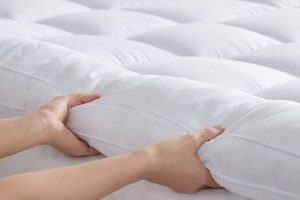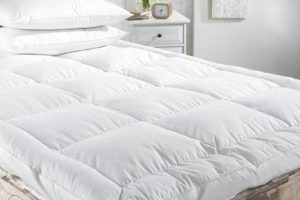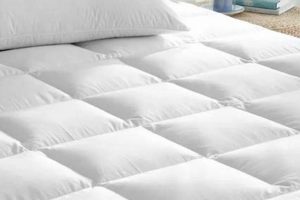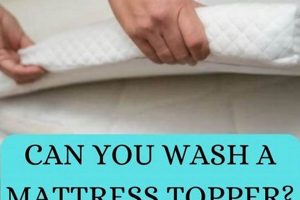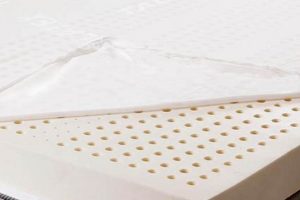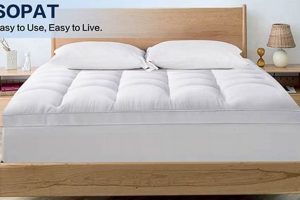The lifespan of a mattress topper is variable, influenced by factors such as material composition, frequency of use, and maintenance practices. This duration can range from one to eight years, with significant differences observed between various types of toppers. For instance, a memory foam topper might last longer than a feather or down alternative topper, given its density and resilience.
Understanding the expected duration of a mattress topper provides consumers with a basis for making informed purchasing decisions. A product with a longer life cycle represents a more sustainable and cost-effective investment over time. Furthermore, a well-maintained topper can significantly enhance sleep quality and extend the life of the underlying mattress, contributing to overall comfort and support. In the past, mattress toppers were primarily used for added comfort, but modern iterations also focus on pressure relief, temperature regulation, and protection of the mattress itself.
Therefore, a detailed examination of factors impacting the longevity of different mattress topper materials, alongside recommended maintenance practices, is essential to maximize the investment and ensure optimal performance throughout its usable life. Considerations of material, density, and care routines are crucial for predicting the period of effectiveness and value derived from the product.
Maximizing Mattress Topper Lifespan
To extend the period a mattress topper remains effective and comfortable, adherence to specific maintenance and usage guidelines is essential. Proper care can significantly affect the duration of its utility.
Tip 1: Employ a Mattress Protector. A mattress protector forms a barrier against spills, stains, and allergens, all of which can degrade the topper material. Regularly washing the protector is crucial for hygiene.
Tip 2: Rotate the Topper Regularly. Periodic rotation, typically every three to six months, ensures even wear and prevents depressions from forming in areas of concentrated pressure.
Tip 3: Follow Manufacturer Cleaning Instructions. Each material type requires distinct cleaning protocols. Adhering to the manufacturers recommendations, found on the care label, will avoid damage or shrinkage.
Tip 4: Vacuum Regularly. Vacuuming the topper surface helps remove dust mites, dead skin cells, and other particles that can accumulate over time. Use an upholstery attachment for best results.
Tip 5: Avoid Direct Sunlight. Prolonged exposure to direct sunlight can cause certain materials, particularly memory foam, to degrade and lose their structural integrity. Keep the topper covered when not in use.
Tip 6: Support the Entire Surface. Ensure the mattress foundation provides adequate support across the entire area of the topper. Insufficient support can lead to uneven wear and premature failure.
Tip 7: Consider Material-Specific Care. Latex, memory foam, feather, and other materials require tailored care approaches. Researching best practices for the specific material will optimize its lifespan.
Following these guidelines can substantially increase the duration of a mattress toppers effectiveness, preserving comfort and functionality. Consistent upkeep translates to a greater return on the initial investment.
Effective implementation of these tips will help extend the period of performance, maintaining comfort and support over a longer duration.
1. Material Composition
The lifespan of a mattress topper is significantly influenced by its material composition. The inherent properties of the material determine its resistance to compression, deformation, and degradation over time. Different materials exhibit varying degrees of durability, directly impacting the period for which the topper maintains its intended level of support and comfort. A topper made from high-density memory foam, for example, typically withstands daily use for a more extended period than one constructed from a less dense, less resilient material like fiberfill. The interconnected structure of high-density foam allows it to recover more effectively from repeated compression, resisting sagging and loss of support.
Consider a comparison between two common topper types: latex and feather. Natural latex, particularly Dunlop latex, possesses exceptional durability due to its uniform density and inherent resilience. A latex topper can often retain its shape and supportive qualities for five to eight years, even with consistent use. Conversely, a feather topper, while offering a plush feel, is more prone to flattening and clumping over time, necessitating more frequent replacement, often within two to three years. The feather’s lack of inherent structural integrity contributes to its shorter lifespan. This highlights how the choice of material directly correlates with the product’s overall longevity.
In summary, the selection of a mattress topper material is a critical determinant of its lifespan. High-density materials with inherent resilience, such as latex or high-density memory foam, offer superior durability and a longer period of effective use compared to less robust alternatives like fiberfill or feather. Understanding this relationship empowers consumers to make informed decisions that prioritize both comfort and long-term value, ultimately influencing the cost-effectiveness of the investment.
2. Density
Density, measured in pounds per cubic foot (PCF), is a critical determinant of a mattress topper’s durability and, consequently, its lifespan. The higher the density, the more material packed into a given volume, generally resulting in enhanced resistance to compression and deformation. This characteristic directly influences how long the topper maintains its supportive qualities.
- Resistance to Sagging
Higher density foams, such as those exceeding 4 PCF, exhibit superior resistance to sagging and permanent indentations. When subjected to consistent weight and pressure, these foams retain their original shape more effectively compared to lower density alternatives. This resistance directly translates to a longer useful life, as the topper continues to provide consistent support and pressure relief.
- Impact on Material Degradation
Increased density often correlates with a tighter cell structure within the foam. This structure minimizes air pockets and reduces the potential for internal breakdown due to repeated compression. A denser foam is less susceptible to crumbling or losing its structural integrity, thereby extending the period it remains in optimal condition.
- Support and Pressure Relief
A topper’s ability to offer adequate support and pressure relief diminishes as it loses density through wear and tear. Higher density
materials maintain their firmness and contouring capabilities for a longer duration. This sustained performance is essential for alleviating pressure points and promoting proper spinal alignment, contributing to overall sleep quality and user satisfaction. - Cost-Effectiveness over Time
While higher density toppers may command a higher initial price, their extended lifespan often results in greater cost-effectiveness. The need for less frequent replacement offsets the initial investment, making them a more economical choice in the long run. This consideration is particularly relevant for individuals seeking a long-term solution for improving sleep surface comfort.
In conclusion, the density of a mattress topper material significantly impacts its ability to withstand daily use, resist degradation, and maintain its support characteristics. Opting for a higher density topper typically translates to a longer and more effective product lifespan. This factor should be a primary consideration for consumers seeking a durable and cost-effective solution for enhanced sleep comfort.
3. Usage Frequency
Usage frequency directly influences the degradation rate of a mattress topper, consequently affecting its overall lifespan. The more frequently a topper is subjected to weight and pressure, the more rapidly its materials break down, diminishing its supportive capabilities. Therefore, usage patterns are a significant factor in estimating the period a mattress topper remains effective.
- Daily vs. Occasional Use
A topper used daily experiences continuous compression and expansion cycles. These cycles induce fatigue within the material, leading to a gradual loss of resilience. In contrast, a topper used only in a guest room or on an occasional basis will experience significantly less wear, resulting in a longer lifespan. For instance, a topper used daily by a heavy individual might show signs of compression within a year, whereas the same topper used only a few times a month could remain supportive for several years.
- Weight Distribution and Movement
Consistent weight distribution across the surface of the topper minimizes localized stress points. However, frequent tossing and turning, or concentrated pressure in specific areas (e.g., hips, shoulders), accelerates wear in those zones. The resulting uneven compression contributes to a reduction in the toppers overall effectiveness, leading to premature replacement. Sleep position and body weight, therefore, are integral considerations.
- Impact on Different Materials
The effect of usage frequency varies depending on the topper’s material. Memory foam, known for its conforming properties, might exhibit indentation more quickly under heavy, frequent use. Latex, with its inherent resilience, tends to withstand daily use better than feather or down alternatives. A feather topper, subjected to constant compression, will require more frequent fluffing and is likely to degrade faster compared to a latex or high-density foam model.
- Relationship to Maintenance
Frequent use necessitates more diligent maintenance to mitigate the effects of wear. Regular rotation, cleaning, and the use of a mattress protector become even more critical in high-use scenarios. Failure to address these needs can accelerate degradation and shorten the topper’s lifespan. Thus, usage frequency and maintenance practices are intrinsically linked in determining longevity.
The intensity and consistency of use are primary factors influencing how long a mattress topper maintains its intended functionality. Recognizing the interplay between usage frequency, material properties, and maintenance routines is essential for maximizing its useful life and extracting optimal value from the investment.
4. Maintenance Practices
Maintenance practices exert a significant influence on the functional lifespan of a mattress topper. The correlation between adherence to appropriate care protocols and the duration of effectiveness is direct and quantifiable. Insufficient or improper upkeep invariably leads to accelerated degradation, diminished performance, and a reduced product lifespan. For instance, regular vacuuming removes dust mites and allergens, preventing material breakdown and maintaining hygiene. Conversely, neglect in this area promotes allergen accumulation, fostering a less sanitary and potentially damaging environment within the topper’s structure.
The application of a mattress protector serves as a preventive measure against stains, spills, and general wear. The barrier created by the protector shields the topper material from direct contact with external contaminants, reducing the frequency and intensity of cleaning required. Rotation practices, implemented every few months, distribute wear evenly across the surface, preventing localized compression and extending the period of uniform support. Material-specific cleaning methods are critical; harsh chemicals can degrade certain materials, while gentle, recommended cleaning agents preserve integrity. Failing to adhere to these material-specific recommendations can result in irreversible damage and premature failure.
In summary, consistent and appropriate maintenance represents a critical determinant of a mattress topper’s longevity. By implementing a regimen of regular cleaning, protection, rotation, and material-specific care, users can substantially extend the useful life of the product, maximizing its value and sustaining its performance over time. Recognizing the causal relationship between upkeep and lifespan empowers consumers to make informed decisions and proactively manage the condition of their mattress toppers, ensuring a prolonged period of comfort and support.
5. Weight Applied
The amount of weight consistently applied to a mattress topper is a primary factor influencing its lifespan. The material composition and density of the topper interact with the pressure exerted, affecting the rate of degradation and, consequently, the period over which the topper maintains its intended performance characteristics.
- Compression and Material Fatigue
Sustained weight induces compression within the topper’s materials. Over time, this compression leads to material fatigue, particularly in foams. Higher weight accelerates this process, causing the topper to lose its support and resilience more rapidly. For example, a topper subjected to 250 pounds of weight daily will exhibit compression sooner than an identical topper supporting only 150 pounds. This difference in applied force directly impacts the structural integrity and useful duration of the topper.
- Localized Pressure Points
Uneven weight distribution exacerbates the effects of compression. If a significant portion of the applied weight is concentrated in specific areas, these pressure points will experience accelerated wear. This is especially relevant for individuals who favor certain sleeping positions or have uneven body weight distribution. Localized pressure points result in sagging or indentations, reducing overall comfort and comp
romising the toppers ability to provide consistent support. - Material Density and Load Capacity
A mattress topper’s density determines its ability to withstand applied weight. Higher density materials possess greater load capacity, enabling them to support heavier individuals without experiencing rapid compression. Conversely, lower density materials are more susceptible to deformation under the same load. The material’s inherent ability to distribute and support weight is critical in predicting the degradation rate under specific loading conditions. A high-density latex topper, for example, would generally offer a longer lifespan under heavier weight than a low-density memory foam option.
- Impact on Topper Construction
The internal construction of a topper also plays a role in withstanding weight. Some toppers incorporate internal support structures or layered designs to distribute weight more effectively. These design features can mitigate the effects of compression and extend the topper’s lifespan, particularly for individuals with higher body weights. A topper with reinforced edge support, for example, will resist sagging along the perimeter, ensuring consistent support across the entire surface, even under significant weight.
The interaction between applied weight, material density, and internal construction significantly influences the longevity of a mattress topper. Understanding these factors enables consumers to make informed decisions, selecting toppers with appropriate load capacities and construction features to maximize their lifespan under specific weight-bearing conditions. Proper assessment of weight applied contributes to a more accurate prediction of how long a topper will maintain its performance characteristics, ensuring a more cost-effective and satisfactory investment.
6. Mattress Quality
Mattress quality exerts a notable influence on a mattress topper’s lifespan and performance. The support provided by the underlying mattress directly affects the distribution of weight and pressure across the topper’s surface. A high-quality mattress offers consistent support, preventing localized sagging and minimizing stress on the topper. Conversely, a worn or inadequate mattress may exhibit uneven support, causing the topper to compensate for the mattress’s deficiencies. This compensatory action accelerates the topper’s degradation, reducing its effective lifespan.
Consider two scenarios: a high-density memory foam topper placed on a new, firm innerspring mattress versus the same topper placed on a sagging, ten-year-old mattress. In the first scenario, the mattress provides even support, allowing the topper to function as intended enhancing comfort and pressure relief without bearing excessive weight stress. In the second scenario, the topper is forced to conform to the uneven surface of the sagging mattress, compressing more in some areas than others. This uneven distribution of weight causes premature wear and potential deformation of the topper, shortening its lifespan significantly. Furthermore, the toppers material can begin to mimic the underlying flaws of the mattress, rendering it less effective for its primary purposes.
In conclusion, the quality of the underlying mattress plays a pivotal role in maximizing the lifespan and performance of a mattress topper. Investing in a supportive and structurally sound mattress not only enhances sleep quality but also protects the topper from premature degradation, ensuring a more cost-effective and comfortable sleep solution. Prioritizing mattress quality is therefore an essential consideration when assessing the long-term value of a mattress topper investment.
Frequently Asked Questions
This section addresses common inquiries regarding the expected lifespan of mattress toppers, providing guidance on factors influencing their durability and performance.
Question 1: What is the average lifespan of a mattress topper?
The average lifespan ranges from one to eight years, dependent on material composition, usage frequency, and maintenance practices. Higher-quality materials and diligent care extend the period of effectiveness.
Question 2: Which type of mattress topper typically lasts the longest?
Latex and high-density memory foam toppers generally exhibit greater longevity compared to down, feather, or fiberfill alternatives due to their inherent resilience and resistance to compression.
Question 3: How does body weight impact a mattress topper’s lifespan?
Increased body weight places greater stress on the topper’s materials, accelerating compression and degradation. Toppers supporting heavier individuals may require more frequent replacement.
Question 4: Can a mattress protector extend the lifespan of a mattress topper?
Yes, a mattress protector creates a barrier against spills, stains, and allergens, preventing damage to the topper’s materials and prolonging its useful life.
Question 5: How often should a mattress topper be rotated?
Rotating the topper every three to six months ensures even wear and prevents localized compression, contributing to a more uniform and extended lifespan.
Question 6: What cleaning methods are recommended for mattress toppers?
Cleaning methods vary depending on the topper material. Adherence to manufacturer-specified cleaning protocols is crucial to avoid damage and maintain the topper’s integrity.
In summary, the lifespan of a mattress topper is subject to various influencing factors. By considering material quality, usage patterns, and maintenance requirements, one can optimize the period for which the topper provides comfort and support.
The succeeding section will delve into indicators suggesting that a mattress topper needs replacement, guiding users in assessing the condition and performance of their existing toppers.
Determining Topper Replacement Timeline
An examination of how long does a mattress topper last reveals a range of variables, including material, usage, and maintenance, all of which dictate its functional duration. Consistent performance monitoring, coupled with adherence to recommended care protocols, is paramount for maximizing its value. Deviation from these practices invariably diminishes its effective lifespan.
Ultimately, understanding the factors influencing a topper’s longevity enables a more informed approach to purchasing and care, thereby optimizing comfort and support over time. Timely assessment and replacement, when warranted, ensure sustained sleep quality and prevent reliance on a compromised product.


